Brian Zinchuk is editor and owner of Pipeline Online

EDMONTON – A series of “grid alerts” on the Alberta electrical power grid over the last year, in particular events in January and April of this year, have shaken up the Alberta government enough to move it to action. On Aug. 6, the Alberta government announced substantial changes to the province’s deregulated grid, meant to ensure the critical stability that has been slipping away in recent months.
This comes as the Alberta grid shut down its last coal-fired power station in late June, converting it to natural gas. Also, in the last 31 months, Alberta has essentially doubled its wind and solar power generating assets, at least when it comes to nameplate capacity. But as Pipeline Online has extensively reported, each time Alberta goes into a grid alert, wind generation has flatlined, and the sun is on the wrong side of the planet. And that over-reliance on wind, especially to perform, when it does not, seems to be at the crux of the reforms announced.
But that’s not exactly how the report saw it. While it recognized low power power generation was a factor, it largely places the blame on outages in natural gas-fired thermal generation, even though in one of these events wind generation was close to nil.
The Alberta Market Surveillance Administrator (MSA) released a detailed report on Aug. 6 looking the events of Jan. 13 and April 5, 2024, when the Alberta grid was most threatened. The Alberta Electric System Operator, or AESO, runs Alberta’s deregulated electrical grid.
Minister of Affordability and Utilities Nathan Neudorf said in a release, “The grid alerts in January and April served as powerful reminders of the importance of having reliable electricity. The recent MSA report provides a thoughtful analysis of these two events and confirms that our government is taking the best course of action to ensure Albertans have affordable and reliable power both now and in the future.”
The Alberta government press release said, “While Alberta’s government undertakes the important work of long-term electricity market reforms, temporary rules were enacted earlier this summer to ensure the grid is reliable and affordable. One of those new rules was the Supply Cushion Regulation, which requires natural gas power plants to be online in times of high demand if there is not enough power to meet Alberta’s needs. The MSA’s report suggests that the rotating outages on April 5 would likely have been avoided if the government’s Supply Cushion Regulation had been in place at the time.
“Engagement is underway on the detailed design of Alberta’s restructured energy market, which will include moving to a day-ahead market where generators will commit their dispatchable power on the previous day, rather than an hour beforehand. The MSA’s report reinforces the Alberta government’s decision to implement a day-ahead market, which will help to better prepare for and respond to power shortages during times of high demand in the province.”
Derek Olmstead, Administrator & CEO, Market Surveillance Administrator, said, “In a day-ahead market, once each day the AESO will look forward to all hours of the next day collectively, minimize the cost of meeting demand the next day, and ensure that all generators needed to meet demand are online (committed). Day-ahead prices are expected to be less volatile than Alberta’s current hourly prices and allow for more efficient natural gas nomination. Market design features like this can reduce the likelihood of load shed events such as the one that occurred on April 5.”
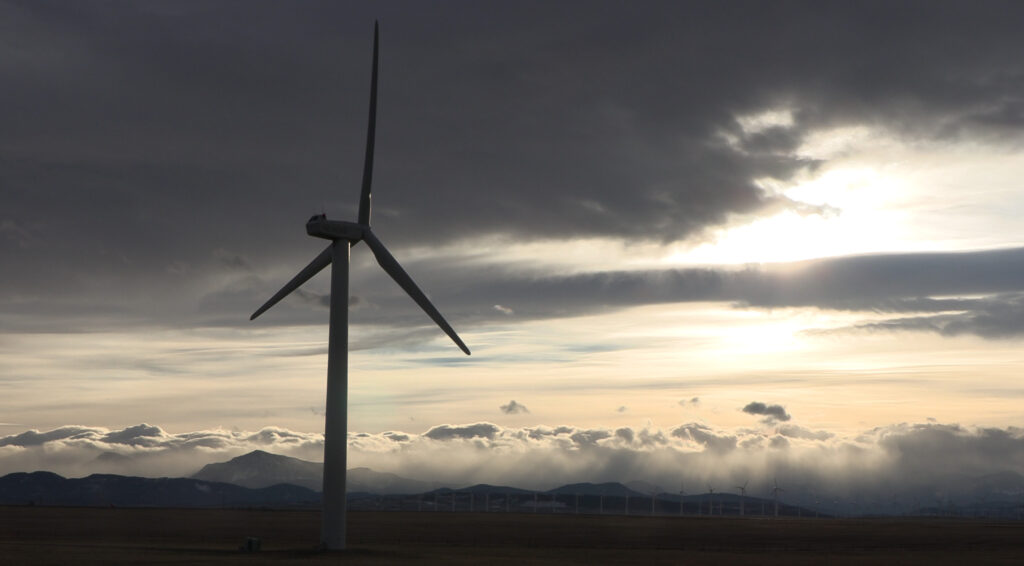
Wind turbine near Pincher Creek, Alberta, on Dec. 1, 2023. A few weeks later, wind’s failure was a key reason the provincial grid went into distress. Photo by Brian Zinchuk
Lots of attention to natural gas, but wind didn’t show up
Fundamentally, in both instances studied in a report, wind did not show up at the plate, and the sun had set or had not yet come up. Similar instances also occurred in several grid alerts in Alberta in the preceding two years, as reported by Pipeline Online, but those were not considered in this report, which you can download in .pdf form here: January-and-April-2024-Event-Report
(Editor’s Note: the report makes extensive usage of the term “HE.” That stands for “hour ending.” So if something happened at 5:17 p.m., that’s 17:17 hours, and the hour ending is 18, as in 18:00 hours. Thus, it would be in HE18. And an EEA is an “Energy Emergency Alert,” also referred to as a “grid alert”. MW is megawatts)
The report goes into great detail on how particular thermal generating units (all but one being natural gas-fired) were not in play for this or that reason. What it does not expressly say that in each of these instances, the vast majority of 89 natural gas fired units at the time were in operation and running flat out, providing almost all the power that kept the lights on. One, solitary coal unit was also at play, but it has since been converted to natural gas.
Hydro power generation is given some attention, but biomass and other generation is largely ignored in the report.
The term “battery” is not mentioned once in the report, despite Alberta having 10 grid-scale batteries. They are obliquely referred within its description of “operating reserves,” noting, “AESO system controllers call upon three types of operating reserve to address unexpected imbalances or lagged responses between supply and demand: regulating reserve, spinning reserve, and supplemental reserve.
“Regulating reserve provides an instantaneous response to an imbalance of supply and demand. Spinning reserve and supplemental reserve are contingency reserves, used to maintain system balance when an unexpected event occurs. Spinning reserve (SR) is synchronized to the grid and provides capacity that the system controller can direct quickly given a sudden drop in supply. Supplemental reserve is not required to be synchronized but must be able to respond within 10 minutes if directed by the system controller. Supplemental reserves can be provided by both generation (SUPG) and load (SUPL).”
By tracking the time SUPG was implemented to the usage of the province’s batteries, it appears that SUPG is a reference to batteries. In the Jan. 13 event, they were at play only 66 minutes.
- 0098 SASPO-2874_Self Serve Campaign_New Connects_Youtube_v30098 SASPO-2874_Self Serve Campaign_New Connects_Youtube_v3
- 0100 Turnbull Project Manager0100 Turnbull Project Manager
- 0099 Mryglod Steel 1080p0099 Mryglod Steel 1080p
- 0097 Eagle Sky Ventures LTD0097 Eagle Sky Ventures LTD
- 0095 Fast Trucking nearly 70 years good at it0095 Fast Trucking nearly 70 years good at it
- 0053 Kingston Midstream Westspur Alameda Click Before You Dig0053 Kingston Midstream Westspur Alameda Click Before You Dig
- 0092 Turnbull projects big and small0092 Turnbull projects big and small
- 0046 City of Estevan This is Estevan Teaser0046 City of Estevan This is Estevan Teaser
- 0087 Lori Carr Coal Expansion0087 Lori Carr Coal Expansion
- 0077 Caprice Resources Stand Up For Free Speech0077 Caprice Resources Stand Up For Free Speech
- 0076 Latus only0076 Latus only
- 0061 SIMSA 2024 For Sask Buy Sask0061 SIMSA 2024 For Sask Buy Sask
- 0055 Smart Power Be Smart with your Power office0055 Smart Power Be Smart with your Power office
- 0051 JML Hiring Pumpjack assembly0051 JML Hiring Pumpjack assembly
- 0049 Scotsburn Dental soft guitar0049 Scotsburn Dental soft guitar
- 0041 DEEP Since 2018 now we are going to build0041 DEEP Since 2018 now we are going to build
- 0032 IWS Summer hiring rock trailer music
- 0022 Grimes winter hiring
- 0021 OSY Rentals S8 Promo
- 0018 IWS Hiring Royal Summer
- 0013 Panther Drilling PO ad 03 top drive rigs
- 0006 JK Junior
- 0002 gilliss casing services0002 gilliss casing services
- 9002 Pipeline Online 30 sec EBEX9002 Pipeline Online 30 sec EBEX
- 9001
Executive summary
The executive summary of the report said this about the January event:
January 13 use of the Alberta Emergency Alert public warning system
The January 13 event occurred during a week-long extreme cold snap that saw temperatures in Alberta plummet below -40°C. The grid was stressed by several temperature-driven factors, including record high demand and equipment failures, leading to generation outages. British Columbia and the U.S. Northwest experienced similar weather conditions, which limited the availability of imports from other jurisdictions.
Leading up to January 13, the AESO’s adequacy forecasts predicted tight but manageable conditions. Low wind generation was expected, but other supply sources were forecast by the AESO to be sufficient. However, rising demand and unanticipated generation outages led to Energy Emergency Alert notices from the AESO and imminent load shed. Consequently, the Alberta Emergency Management Agency issued an Alberta Emergency Alert urging Albertans to limit non-essential electricity use (the “Alert”).
The Alert was broadcast over TV, radio, websites, social media, the Alberta Emergency Alert mobile app, and compatible smart phones. The MSA estimates the Alert reduced demand by approximately 350 MW over an hour. As a result, no firm load was shed during this event.
And it said this about the April event:
Load shed event on April 5
The April 5 event was different in that high demand was not a contributing factor. On April 3, a supply surplus event was quickly followed by an Energy Emergency Alert after the coincident loss of approximately 3,000 MW of wind and solar generation. This event demonstrates how supply adequacy can shift rapidly and unexpectedly.
Through the morning of April 5, a series of outages in short succession compounded with existing outages to reduce the supply of thermal generation by approximately 4,000 MW. Combined with approximately 400 MW less wind generation than anticipated, this led to emergency conditions resulting in 244 MW of firm load shed. This was the first firm load shed in the province since 2013.
The report, including the recommendations, makes extensive use of data available to the MSA that are not publicly available, including: regional demand, demand from price responsive loads, AESO emergency directives, including distribution voltage reductions and load shed preparations, outage and derate declarations at the asset level, output underlying the Supply Adequacy Report and Market Supply Cushion Report, contingency reserve directives, and emergency interchange measures, including emergency imports and Northwest Power Pool Reserve Sharing imports.
- 0098 SASPO-2874_Self Serve Campaign_New Connects_Youtube_v30098 SASPO-2874_Self Serve Campaign_New Connects_Youtube_v3
- 0100 Turnbull Project Manager0100 Turnbull Project Manager
- 0099 Mryglod Steel 1080p0099 Mryglod Steel 1080p
- 0097 Eagle Sky Ventures LTD0097 Eagle Sky Ventures LTD
- 0095 Fast Trucking nearly 70 years good at it0095 Fast Trucking nearly 70 years good at it
- 0053 Kingston Midstream Westspur Alameda Click Before You Dig0053 Kingston Midstream Westspur Alameda Click Before You Dig
- 0092 Turnbull projects big and small0092 Turnbull projects big and small
- 0046 City of Estevan This is Estevan Teaser0046 City of Estevan This is Estevan Teaser
- 0087 Lori Carr Coal Expansion0087 Lori Carr Coal Expansion
- 0077 Caprice Resources Stand Up For Free Speech0077 Caprice Resources Stand Up For Free Speech
- 0076 Latus only0076 Latus only
- 0061 SIMSA 2024 For Sask Buy Sask0061 SIMSA 2024 For Sask Buy Sask
- 0055 Smart Power Be Smart with your Power office0055 Smart Power Be Smart with your Power office
- 0051 JML Hiring Pumpjack assembly0051 JML Hiring Pumpjack assembly
- 0049 Scotsburn Dental soft guitar0049 Scotsburn Dental soft guitar
- 0041 DEEP Since 2018 now we are going to build0041 DEEP Since 2018 now we are going to build
- 0032 IWS Summer hiring rock trailer music
- 0022 Grimes winter hiring
- 0021 OSY Rentals S8 Promo
- 0018 IWS Hiring Royal Summer
- 0013 Panther Drilling PO ad 03 top drive rigs
- 0006 JK Junior
- 0002 gilliss casing services0002 gilliss casing services
- 9002 Pipeline Online 30 sec EBEX9002 Pipeline Online 30 sec EBEX
- 9001
The executive summary of the report listed seven recommendations:
RECOMMENDATIONS
The MSA makes the following seven recommendations based on the observations set out in this report, as well as its broader understanding of current and potential future issues in Alberta’s electricity market.
-
The AESO should ensure that an efficient and effective unit commitment process is developed as part of the Restructured Energy Market (REM) / Day-Ahead Market (DAM): the tolerance of supply shortfall risk is inherently higher for generation owners than for the public. On April 5, Battle River 5 was commercially offline when load was shed. Under the provisions of the SCR, the asset would have been committed by the AESO, and if the asset had been able to respond, no load would have been shed.
-
The AESO should review the calculation of market supply cushion and retain all published data: the AESO has implemented amendments to its Market Supply Cushion Report that may improve its ability to forecast tight supply conditions. The AESO should seek out opportunities for other improvements to the underlying forecast data, such as net imports and constrained down generation. This is especially important as the report forms the basis for unit commitment decisions under the SCR. Further, the AESO should retain all data it publishes, including for the Market Supply Cushion Report, to facilitate monitoring of unit commitment decisions, identify opportunities to improve the forecast, and ensure compliance with the SCR.
-
The AESO should publish methodology used to determine import capability under emergency conditions: the AESO should make public the methodology used to determine BC/MATL import capability while operating under emergency conditions, or conditions not represented in ISO rule 203.6, Available Transfer Capability and Transfer Path Management and related documentation.
-
The AESO should publish system event reports: there will be learnings from events related to grid operations that the AESO is positioned to uncover and share with industry. The AESO has prepared public event reports in the past and should do so following system events.
With the enactment of the SCR, the accuracy of certain data market participants submit to the AESO are of increased importance due to how they impact the AESO’s ability to discharge its responsibilities under the SCR. The AESO should devote sufficient compliance monitoring resources to identify instances of suspected contraventions and refer these, if any, to the MSA. The MSA will place high priority on potential contraventions that hinder the AESO’s ability to effectively discharge its responsibilities under the SCR.
-
Market participants should improve available capability declarations submitted to the AESO: some generation assets routinely submit default availability declarations until close to real time. These default submissions declare that the asset can provide its full capacity, or close to full capacity, when often temperatures or site conditions mean this is
-
Market participants should improve the input of physical parameters that may be relevant to unit commitment decisions made by the AESO: market participants must ensure that the physical parameters entered for their assets are accurate and up to date, including initial start-up times that are dependent on the status of the unit (e.g., how warm it is).
-
Market participants should improve the quality of outage reasons submitted to the AESO: outage reasons declared by market participants are not always adequately descriptive. More descriptive outage reasons should be provided by market participants and outage reasons should be routinely audited by the AESO, including physical audits as appropriate.
- 0098 SASPO-2874_Self Serve Campaign_New Connects_Youtube_v30098 SASPO-2874_Self Serve Campaign_New Connects_Youtube_v3
- 0100 Turnbull Project Manager0100 Turnbull Project Manager
- 0099 Mryglod Steel 1080p0099 Mryglod Steel 1080p
- 0097 Eagle Sky Ventures LTD0097 Eagle Sky Ventures LTD
- 0095 Fast Trucking nearly 70 years good at it0095 Fast Trucking nearly 70 years good at it
- 0053 Kingston Midstream Westspur Alameda Click Before You Dig0053 Kingston Midstream Westspur Alameda Click Before You Dig
- 0092 Turnbull projects big and small0092 Turnbull projects big and small
- 0046 City of Estevan This is Estevan Teaser0046 City of Estevan This is Estevan Teaser
- 0087 Lori Carr Coal Expansion0087 Lori Carr Coal Expansion
- 0077 Caprice Resources Stand Up For Free Speech0077 Caprice Resources Stand Up For Free Speech
- 0076 Latus only0076 Latus only
- 0061 SIMSA 2024 For Sask Buy Sask0061 SIMSA 2024 For Sask Buy Sask
- 0055 Smart Power Be Smart with your Power office0055 Smart Power Be Smart with your Power office
- 0051 JML Hiring Pumpjack assembly0051 JML Hiring Pumpjack assembly
- 0049 Scotsburn Dental soft guitar0049 Scotsburn Dental soft guitar
- 0041 DEEP Since 2018 now we are going to build0041 DEEP Since 2018 now we are going to build
- 0032 IWS Summer hiring rock trailer music
- 0022 Grimes winter hiring
- 0021 OSY Rentals S8 Promo
- 0018 IWS Hiring Royal Summer
- 0013 Panther Drilling PO ad 03 top drive rigs
- 0006 JK Junior
- 0002 gilliss casing services0002 gilliss casing services
- 9002 Pipeline Online 30 sec EBEX9002 Pipeline Online 30 sec EBEX
- 9001
Jan. 13 sees grid brought to the brink
Of the Jan. 13 alert, the report noted, “While the Alert was effective, the MSA notes that routine use of the Alberta Emergency Alert program during EEA events may result in diminished consumer response over time. Evidence from the Flex Alert program in California suggests that voluntary demand response alerts can effective but are unreliable and tend to perform worse in extreme weather events when the grid is most strained.”
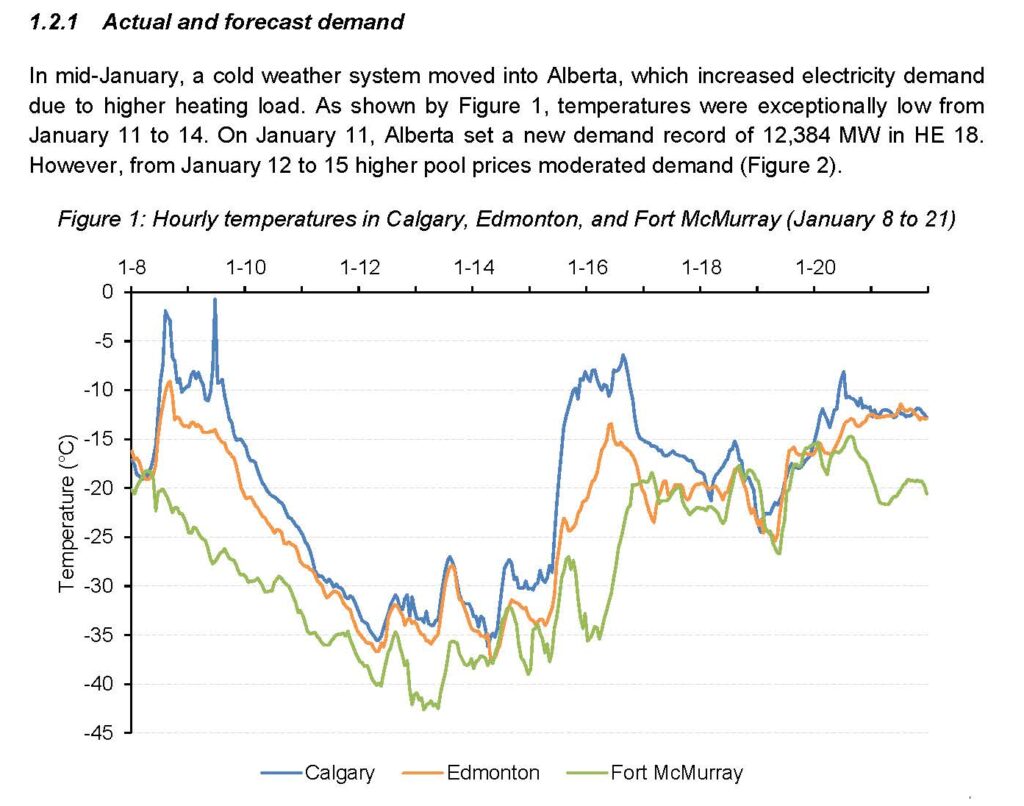
The report digs deep into the impact of -38 C temperatures and how it affected demand. It notes, “Thermal generator outages at Sundance 6, Cloverbar 3, HR Milner, Cascade 1, Syncrude #1, Genesee 1, and Cavalier, reduced supply during the EEA event on January 13. In addition, there were outages at two of the larger hydro assets in the province.”
It goes into detail on why each of those thermal units were down, several of which were scheduled to be down for maintenance well in advance. It also points out that some thermal units oversold their generating capacity, saying, “As of January 6, some assets declared their default availability for January 13, i.e., the declared availability was set equal to, or close to, the asset’s maximum capability. The actual availabilities for the Fort Hills (FH1) and Nexen Inc #2 (NX02) assets were later lowered to reflect ambient temperatures. The availability of Christina Lake (MEG1) was later lowered to reflect site conditions, and the availability of Syncrude #1 (SCL1) was later lowered to reflect ambient temperatures, site conditions, and some generator outages at the site.”

Capital Power’s Genesee Power Plant is seen near Edmonton in an Oct. 19, 2022, handout photo. THE CANADIAN PRESS/HO-Capital Power, Jimmy Jeong,
This is a significant issue referenced several times during the report. In many instances, particular thermal generators would tell the AESO they could run at their full capacity, but that really wasn’t the case. And they would only refine that number a few hours before it was actually needed, leaving the AESO with essentially phantom megawatts that couldn’t be relied upon when the time came.
In total, nine thermal units across the province said they could produce a total of 2,183 megawatts, but in reality they could only produce 1,274, a shortfall of 909 megawatts. And one of those units, Cascadia 1, was brand new, in the process of commissioning.
Hydro was also affected. “Due to the cold weather, icing restrictions derated some of the larger hydro generators in the province on the evening of January 13. For example, the Brazeau (BRA) asset was derated from 350 MW to 160 MW beginning at around 17:30.”
- 0098 SASPO-2874_Self Serve Campaign_New Connects_Youtube_v30098 SASPO-2874_Self Serve Campaign_New Connects_Youtube_v3
- 0100 Turnbull Project Manager0100 Turnbull Project Manager
- 0099 Mryglod Steel 1080p0099 Mryglod Steel 1080p
- 0097 Eagle Sky Ventures LTD0097 Eagle Sky Ventures LTD
- 0095 Fast Trucking nearly 70 years good at it0095 Fast Trucking nearly 70 years good at it
- 0053 Kingston Midstream Westspur Alameda Click Before You Dig0053 Kingston Midstream Westspur Alameda Click Before You Dig
- 0092 Turnbull projects big and small0092 Turnbull projects big and small
- 0046 City of Estevan This is Estevan Teaser0046 City of Estevan This is Estevan Teaser
- 0087 Lori Carr Coal Expansion0087 Lori Carr Coal Expansion
- 0077 Caprice Resources Stand Up For Free Speech0077 Caprice Resources Stand Up For Free Speech
- 0076 Latus only0076 Latus only
- 0061 SIMSA 2024 For Sask Buy Sask0061 SIMSA 2024 For Sask Buy Sask
- 0055 Smart Power Be Smart with your Power office0055 Smart Power Be Smart with your Power office
- 0051 JML Hiring Pumpjack assembly0051 JML Hiring Pumpjack assembly
- 0049 Scotsburn Dental soft guitar0049 Scotsburn Dental soft guitar
- 0041 DEEP Since 2018 now we are going to build0041 DEEP Since 2018 now we are going to build
- 0032 IWS Summer hiring rock trailer music
- 0022 Grimes winter hiring
- 0021 OSY Rentals S8 Promo
- 0018 IWS Hiring Royal Summer
- 0013 Panther Drilling PO ad 03 top drive rigs
- 0006 JK Junior
- 0002 gilliss casing services0002 gilliss casing services
- 9002 Pipeline Online 30 sec EBEX9002 Pipeline Online 30 sec EBEX
- 9001
No mention of wind’s Achilles’ heel
But what MSA report does not say is that the vast majority of thermal generators were indeed online during this time and producing nearly all the power in Alberta. And while the report notes low wind output, it does not specifically mention the correlation between -30 C temperatures and the required shutdown of wind generation due to cold brittle behaviour of materials in the turbines at that temperature. This was evident in the two days leading up to the Jan. 13 alert. Pipeline Online reported on how wind generation fell to next to nothing as temperatures fell below -30 on Jan. 11, but not for lack of wind.
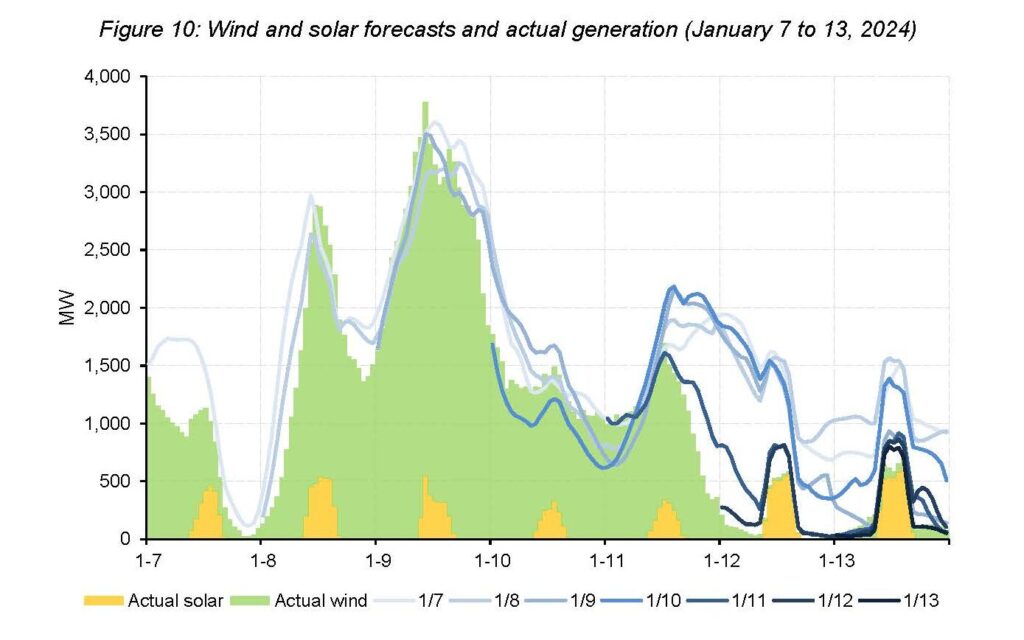
Green indicates wind output. Starting late on Jan. 11, it petered out to next to nothing as a result of -30 C and colder temperatures. The wind forecast lines showed expectations in the days before.
Even if the wind was blowing, turbines cannot be expected to generate power at that temperature lest they shatter. This was not mentioned in the report, but was very much the case on Jan. 11, the first day of the January crisis which saw multiple grid alerts declared.
- 0098 SASPO-2874_Self Serve Campaign_New Connects_Youtube_v30098 SASPO-2874_Self Serve Campaign_New Connects_Youtube_v3
- 0100 Turnbull Project Manager0100 Turnbull Project Manager
- 0099 Mryglod Steel 1080p0099 Mryglod Steel 1080p
- 0097 Eagle Sky Ventures LTD0097 Eagle Sky Ventures LTD
- 0095 Fast Trucking nearly 70 years good at it0095 Fast Trucking nearly 70 years good at it
- 0053 Kingston Midstream Westspur Alameda Click Before You Dig0053 Kingston Midstream Westspur Alameda Click Before You Dig
- 0092 Turnbull projects big and small0092 Turnbull projects big and small
- 0046 City of Estevan This is Estevan Teaser0046 City of Estevan This is Estevan Teaser
- 0087 Lori Carr Coal Expansion0087 Lori Carr Coal Expansion
- 0077 Caprice Resources Stand Up For Free Speech0077 Caprice Resources Stand Up For Free Speech
- 0076 Latus only0076 Latus only
- 0061 SIMSA 2024 For Sask Buy Sask0061 SIMSA 2024 For Sask Buy Sask
- 0055 Smart Power Be Smart with your Power office0055 Smart Power Be Smart with your Power office
- 0051 JML Hiring Pumpjack assembly0051 JML Hiring Pumpjack assembly
- 0049 Scotsburn Dental soft guitar0049 Scotsburn Dental soft guitar
- 0041 DEEP Since 2018 now we are going to build0041 DEEP Since 2018 now we are going to build
- 0032 IWS Summer hiring rock trailer music
- 0022 Grimes winter hiring
- 0021 OSY Rentals S8 Promo
- 0018 IWS Hiring Royal Summer
- 0013 Panther Drilling PO ad 03 top drive rigs
- 0006 JK Junior
- 0002 gilliss casing services0002 gilliss casing services
- 9002 Pipeline Online 30 sec EBEX9002 Pipeline Online 30 sec EBEX
- 9001
The report did say, “The AESO procures wind and solar forecasts over a 7-day forecast period. Within 12 hours of real time, the forecast updates every 10 minutes. The forecast is used for operations and is made publicly available.
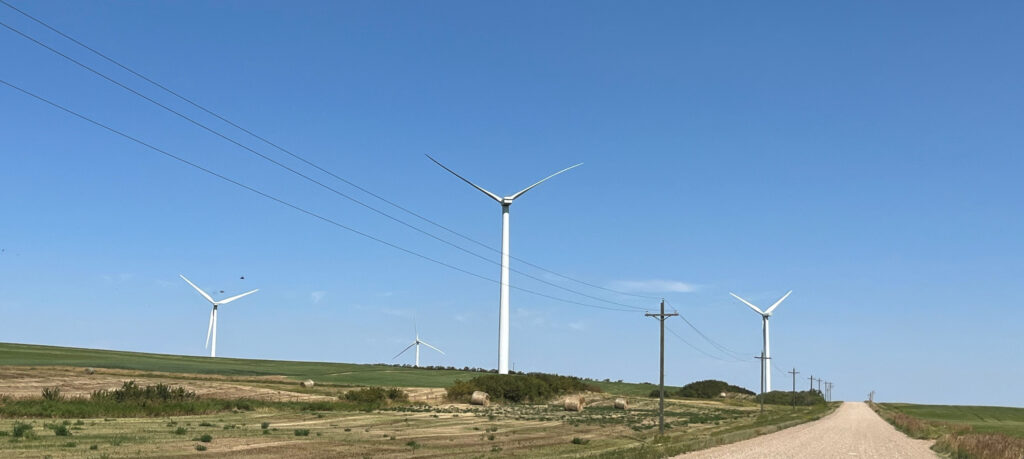
Wind turbines south of Drumheller on Aug. 2, 2024. Photo by Courtney Stroud
“Figure 10 shows wind and solar forecast versions as of midnight on each day from January 7 through 13. Early forecast versions performed well up until midday on January 11, when wind generation fell from approximately 1,350 MW to almost 0 MW. This drop off was first anticipated by the wind forecast version from January 11. Going into January 12, the difference between the January 11 forecast version and previous versions was approximately 1,000 MW.
“Forecasts from January 11 to 13 correctly anticipated very low wind generation but overestimated peak solar generation by approximately 200 MW. The January 12 version incorrectly forecasted an increase in wind generation late in the afternoon on January 13.
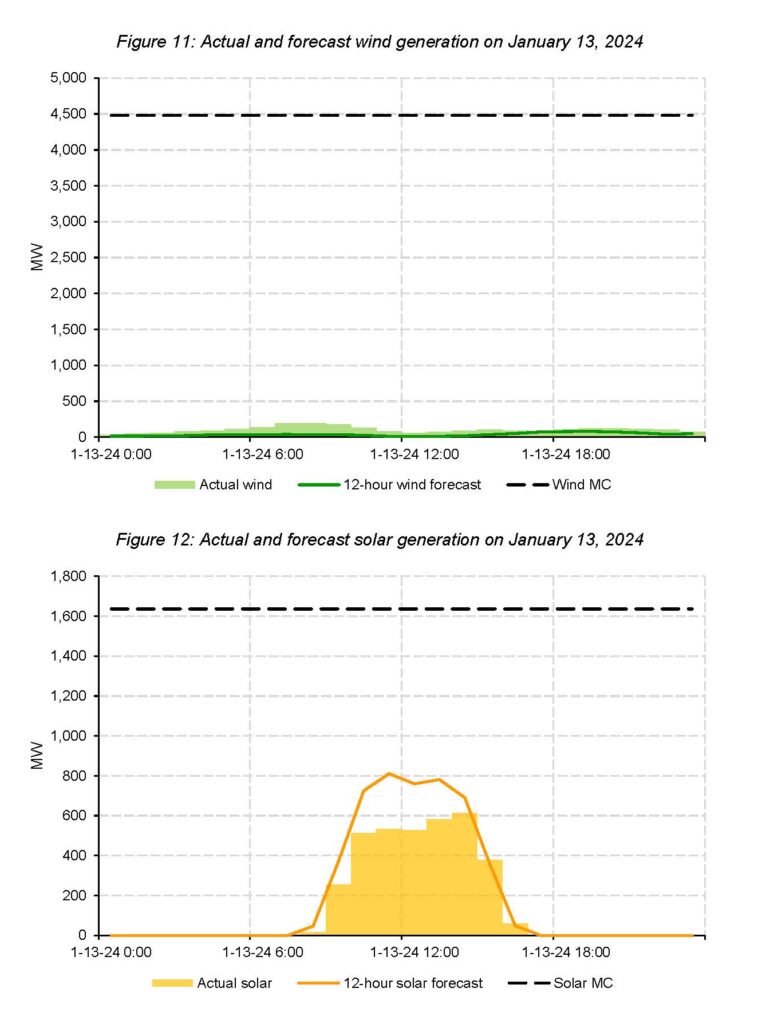
The green is wind production on Jan. 13, while the black dashed line on the top is the nameplate capacity. Wind produced next to nothing all day. And the yellow shows solar output maxing out at about a third of capacity before dropping off. And when it did, the grid alert hit.
- 0098 SASPO-2874_Self Serve Campaign_New Connects_Youtube_v30098 SASPO-2874_Self Serve Campaign_New Connects_Youtube_v3
- 0100 Turnbull Project Manager0100 Turnbull Project Manager
- 0099 Mryglod Steel 1080p0099 Mryglod Steel 1080p
- 0097 Eagle Sky Ventures LTD0097 Eagle Sky Ventures LTD
- 0095 Fast Trucking nearly 70 years good at it0095 Fast Trucking nearly 70 years good at it
- 0053 Kingston Midstream Westspur Alameda Click Before You Dig0053 Kingston Midstream Westspur Alameda Click Before You Dig
- 0092 Turnbull projects big and small0092 Turnbull projects big and small
- 0046 City of Estevan This is Estevan Teaser0046 City of Estevan This is Estevan Teaser
- 0087 Lori Carr Coal Expansion0087 Lori Carr Coal Expansion
- 0077 Caprice Resources Stand Up For Free Speech0077 Caprice Resources Stand Up For Free Speech
- 0076 Latus only0076 Latus only
- 0061 SIMSA 2024 For Sask Buy Sask0061 SIMSA 2024 For Sask Buy Sask
- 0055 Smart Power Be Smart with your Power office0055 Smart Power Be Smart with your Power office
- 0051 JML Hiring Pumpjack assembly0051 JML Hiring Pumpjack assembly
- 0049 Scotsburn Dental soft guitar0049 Scotsburn Dental soft guitar
- 0041 DEEP Since 2018 now we are going to build0041 DEEP Since 2018 now we are going to build
- 0032 IWS Summer hiring rock trailer music
- 0022 Grimes winter hiring
- 0021 OSY Rentals S8 Promo
- 0018 IWS Hiring Royal Summer
- 0013 Panther Drilling PO ad 03 top drive rigs
- 0006 JK Junior
- 0002 gilliss casing services0002 gilliss casing services
- 9002 Pipeline Online 30 sec EBEX9002 Pipeline Online 30 sec EBEX
- 9001
Supply forecasting
On the topic of forecasting if the grid would have enough power, the report said, “The Supply Adequacy Report was slow to signal increasing scarcity leading up to January 13, while the Market Supply Cushion Report was more effective despite issues with the underlying methodology at the time.”
In other words, the forecasts leading up to the 18th hour of Jan. 13 were expected to be tight, but reality ended up being tighter than allowable. It said, “The Supply Adequacy Report did not anticipate the tight supply conditions on January 13 until the evening before. However, during the event there were no assets commercially offline, price responsive loads had already voluntarily curtailed, and imports were limited due to competition from other jurisdictions.”
As for the “market supply cushion”, in the days leading up to Jan. 13, it became increasingly clear there would be zero cushion available the evening of Jan. 13. In the end, seven hours that evening showed zero megawatts or less of market supply cushion. That cushion is based on “available capability from all generating source assets in Alberta with a maximum capability equal to or greater than 5 MW with a start-up time less than or equal to one hour or with a submitted start time at or before the period being assessed,” plus, estimated output from aggregated generating facilities, a forecasted estimate of total net imports/exports on all interties. From that, you minus the peak forecast load from the day-ahead forecast of Alberta internal load as well as constrained down generation, with the exception of constrained down aggregated generating facilities.
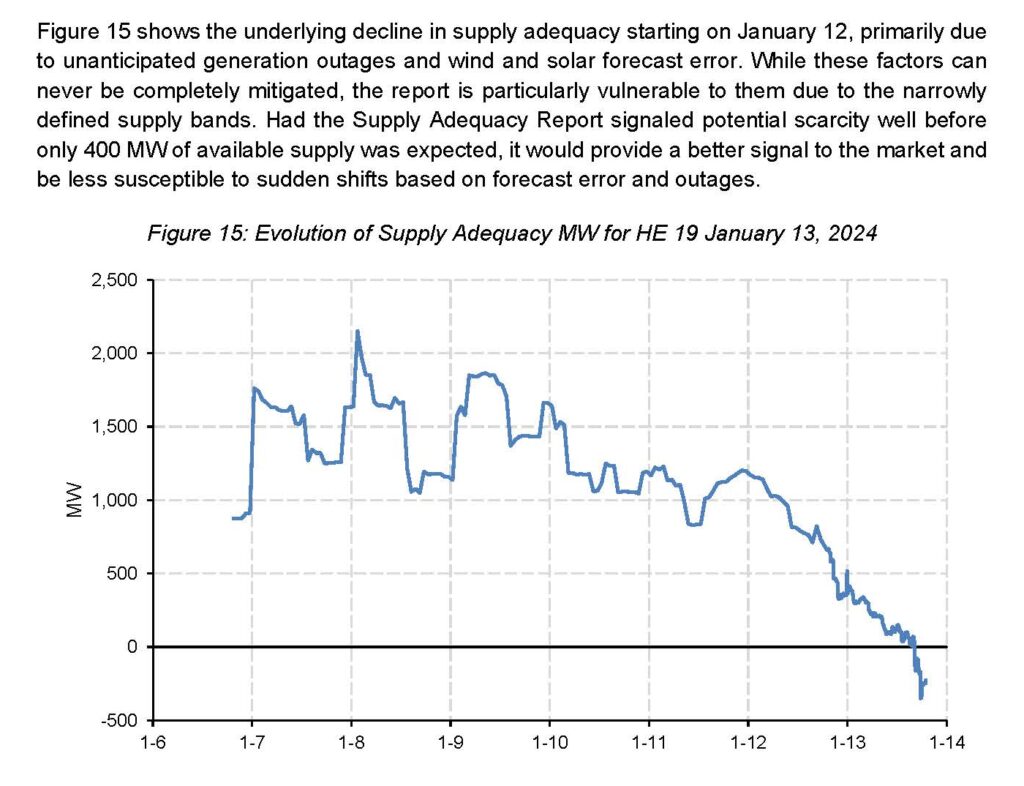
Operating reserves
Electrical grids must maintain an “operating reserve,” also referred to as a “contingency reserve.” If demand exceeds supply, voltage drops and you get a reduction in frequency. The frequency of the electrical grid is a very sensitive thing. If it varies by too much or too long, or both, then major components of the grid start to trip off to protect themselves, compounding the problem immensely, and leading to widespread power outages. When Texas had its crisis in February, 2021,the Texas grid frequency fell below 59.4 hertz for four minutes, 27 seconds. If it had remained below that level for an additional four minutes and 37 seconds, most of the grid would have gone down.
The MSA report said, “Leading up to the Alert, the AESO needed to use up to 100% of contingency reserves to provide energy in order to balance supply and demand. Despite wind and solar generation being low and stable, the AESO maintained a relatively high volume of regulating reserves during the EEA event.
“From 17:32 to 17:37, the AESO directed all 463 MW of its available contingency reserve. Table 9 highlights the periods of time in which 100% of a particular contingency reserve product was directed.”
- 0098 SASPO-2874_Self Serve Campaign_New Connects_Youtube_v30098 SASPO-2874_Self Serve Campaign_New Connects_Youtube_v3
- 0100 Turnbull Project Manager0100 Turnbull Project Manager
- 0099 Mryglod Steel 1080p0099 Mryglod Steel 1080p
- 0097 Eagle Sky Ventures LTD0097 Eagle Sky Ventures LTD
- 0095 Fast Trucking nearly 70 years good at it0095 Fast Trucking nearly 70 years good at it
- 0053 Kingston Midstream Westspur Alameda Click Before You Dig0053 Kingston Midstream Westspur Alameda Click Before You Dig
- 0092 Turnbull projects big and small0092 Turnbull projects big and small
- 0046 City of Estevan This is Estevan Teaser0046 City of Estevan This is Estevan Teaser
- 0087 Lori Carr Coal Expansion0087 Lori Carr Coal Expansion
- 0077 Caprice Resources Stand Up For Free Speech0077 Caprice Resources Stand Up For Free Speech
- 0076 Latus only0076 Latus only
- 0061 SIMSA 2024 For Sask Buy Sask0061 SIMSA 2024 For Sask Buy Sask
- 0055 Smart Power Be Smart with your Power office0055 Smart Power Be Smart with your Power office
- 0051 JML Hiring Pumpjack assembly0051 JML Hiring Pumpjack assembly
- 0049 Scotsburn Dental soft guitar0049 Scotsburn Dental soft guitar
- 0041 DEEP Since 2018 now we are going to build0041 DEEP Since 2018 now we are going to build
- 0032 IWS Summer hiring rock trailer music
- 0022 Grimes winter hiring
- 0021 OSY Rentals S8 Promo
- 0018 IWS Hiring Royal Summer
- 0013 Panther Drilling PO ad 03 top drive rigs
- 0006 JK Junior
- 0002 gilliss casing services0002 gilliss casing services
- 9002 Pipeline Online 30 sec EBEX9002 Pipeline Online 30 sec EBEX
- 9001
Imports
“Although there were limited market-based imports, Alberta received emergency imports from BC and Saskatchewan in addition to imports though the Northwest Power Pool Reserve Sharing Program.”
“Figure 25 shows prices, hourly intertie volumes, and capability of the Saskatchewan (SK) intertie. Over January 13, import ATC on the SK intertie averaged 142 MW and export ATC averaged 140 MW; however, exports were prohibited during the EEA 3 event. On January 13, the import ATC of the SK intertie was increased to 153 MW on an emergency basis;13 it had been largely derated to 90 MW since April 12, 2023. Over the course of the day, flows on SK averaged 88 MW of net imports.”
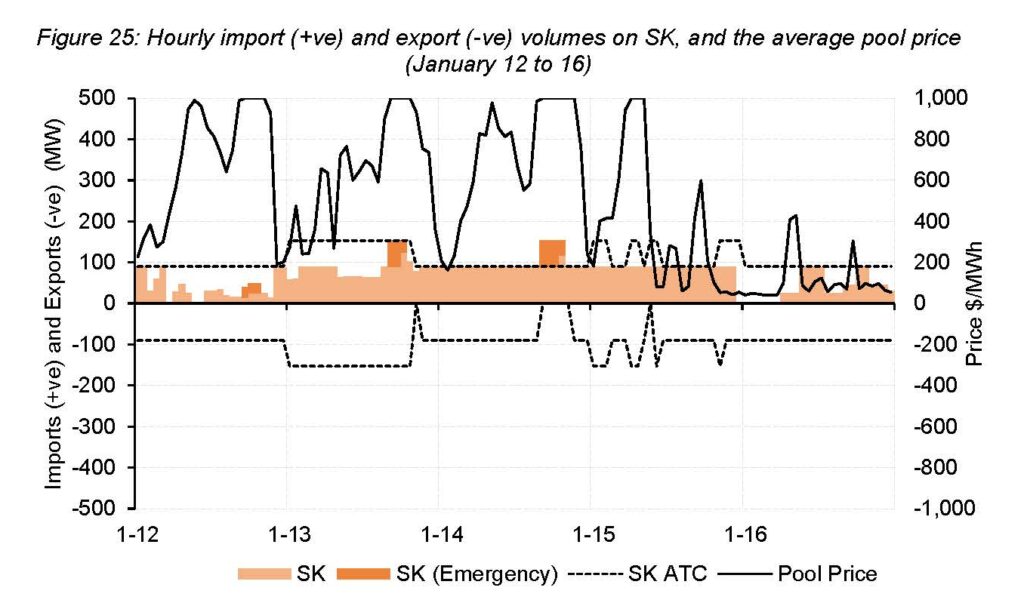
This graph shows a rare glimpse of SaskPower’s interchange with the Alberta grid. The interconnect had been derated but was pushed to the limit for two brief periods on Jan. 13 and 14 to give Alberta everything we could.
“Beginning in HE 17 (4 p.m.), Alberta began receiving emergency imports from Saskatchewan, and the full 153 MW import ATC of the SK intertie was used through HE 19. During HE 20, the SK intertie returned to 90 MW import ATC, and imports were curtailed to this limit (Figure 25).
“Beginning in HE 18 (5 p.m.), Alberta began receiving emergency imports from BC in the range of 100 MW to 260 MW through HE 20. At 17:33 the AESO made a request for 150 MW of Northwest Power Pool reserve sharing imports which lasted until 18:29
- 0098 SASPO-2874_Self Serve Campaign_New Connects_Youtube_v30098 SASPO-2874_Self Serve Campaign_New Connects_Youtube_v3
- 0100 Turnbull Project Manager0100 Turnbull Project Manager
- 0099 Mryglod Steel 1080p0099 Mryglod Steel 1080p
- 0097 Eagle Sky Ventures LTD0097 Eagle Sky Ventures LTD
- 0095 Fast Trucking nearly 70 years good at it0095 Fast Trucking nearly 70 years good at it
- 0053 Kingston Midstream Westspur Alameda Click Before You Dig0053 Kingston Midstream Westspur Alameda Click Before You Dig
- 0092 Turnbull projects big and small0092 Turnbull projects big and small
- 0046 City of Estevan This is Estevan Teaser0046 City of Estevan This is Estevan Teaser
- 0087 Lori Carr Coal Expansion0087 Lori Carr Coal Expansion
- 0077 Caprice Resources Stand Up For Free Speech0077 Caprice Resources Stand Up For Free Speech
- 0076 Latus only0076 Latus only
- 0061 SIMSA 2024 For Sask Buy Sask0061 SIMSA 2024 For Sask Buy Sask
- 0055 Smart Power Be Smart with your Power office0055 Smart Power Be Smart with your Power office
- 0051 JML Hiring Pumpjack assembly0051 JML Hiring Pumpjack assembly
- 0049 Scotsburn Dental soft guitar0049 Scotsburn Dental soft guitar
- 0041 DEEP Since 2018 now we are going to build0041 DEEP Since 2018 now we are going to build
- 0032 IWS Summer hiring rock trailer music
- 0022 Grimes winter hiring
- 0021 OSY Rentals S8 Promo
- 0018 IWS Hiring Royal Summer
- 0013 Panther Drilling PO ad 03 top drive rigs
- 0006 JK Junior
- 0002 gilliss casing services0002 gilliss casing services
- 9002 Pipeline Online 30 sec EBEX9002 Pipeline Online 30 sec EBEX
- 9001
April 2024 load shed event – over the edge
It had been 11 years since Alberta was forced into rolling blackouts, prior to the April 5 event. There wasn’t a lot of demand that day, but this occurred in the springtime, sometimes referred to as the “shoulder season.” That’s when power generators, like SaskPower, do most of their heavy maintenance as demand is reduced since it’s not too cold or too hot, meaning demand is low. Doing maintenance in the upper parts of thermal plant in the middle of summer is extremely difficult, as well, another reason maintenance is done in the spring and fall.
In this case, April 5 was just around 0 C throughout Alberta, and the report said, “It was a low demand day,” at just 17-percentile of demand.
The report said, “Electricity demand was relatively low on April 5 as prevailing temperatures were close to 0°C across Alberta. However, on April 5 the AESO shed firm load for the first time since 2013. Transmission and distribution companies across the province were directed by the AESO to reduce load by a total of 244 MW.”
Here’s the event summary, from the report:
-
The AESO issued 244 MW of load shed instructions at 08:53 (which is in HE 09) on April 5, the first load shed event in Alberta since 2013. Load shed was cancelled at 09:19. Despite demand in HE 09 being only 9,895 MW, there was a high amount of thermal generator outages and low wind generation, which reduced supply.
-
Peak demand on April 5 was low, at 10,195 MW, which is 18% less than the record set on January 11. Two days earlier, pool prices were $0/MWh while demand was approximately 90 MW higher.
-
Outages at Shepard, Muskeg River, Mahkeses, Cloverbar 3, Nexen Inc #1, Sundance 6, Genesee 2, Genesee Repower 1, Cascade 1, and Keephills 2; and several others contributed to approximately 4,000 MW of reduced supply.
-
Battle River 5 was commercially offline during the load shed event and declared a forced outage shortly thereafter.
-
Wind generation ramped down overnight leading up to the load shed, resulting in approximately 400 MW less supply than was forecasted as of midnight on April 5.
-
The Supply Adequacy Report was slow to react to changing supply conditions, while the Market Supply Cushion Report outlook began to signal reduced supply days before the event and continued declining as worsening factors developed overnight.
-
100% of spinning reserves were directed on for 23 minutes and 100% of supplemental reserves were directed on for 156 minutes. These periods coincided for 23 minutes, during which time all contingency reserves were directed to provide energy.
-
Alberta prices were higher than in other jurisdictions, and as a result import capability was fully used through the EEA 3 event. Availability of LSS was limited as loads remained off due to high pool prices. Surrounding the load shed, Alberta received Northwest Power Pool Reserve Sharing imports.
- 0098 SASPO-2874_Self Serve Campaign_New Connects_Youtube_v30098 SASPO-2874_Self Serve Campaign_New Connects_Youtube_v3
- 0100 Turnbull Project Manager0100 Turnbull Project Manager
- 0099 Mryglod Steel 1080p0099 Mryglod Steel 1080p
- 0097 Eagle Sky Ventures LTD0097 Eagle Sky Ventures LTD
- 0095 Fast Trucking nearly 70 years good at it0095 Fast Trucking nearly 70 years good at it
- 0053 Kingston Midstream Westspur Alameda Click Before You Dig0053 Kingston Midstream Westspur Alameda Click Before You Dig
- 0092 Turnbull projects big and small0092 Turnbull projects big and small
- 0046 City of Estevan This is Estevan Teaser0046 City of Estevan This is Estevan Teaser
- 0087 Lori Carr Coal Expansion0087 Lori Carr Coal Expansion
- 0077 Caprice Resources Stand Up For Free Speech0077 Caprice Resources Stand Up For Free Speech
- 0076 Latus only0076 Latus only
- 0061 SIMSA 2024 For Sask Buy Sask0061 SIMSA 2024 For Sask Buy Sask
- 0055 Smart Power Be Smart with your Power office0055 Smart Power Be Smart with your Power office
- 0051 JML Hiring Pumpjack assembly0051 JML Hiring Pumpjack assembly
- 0049 Scotsburn Dental soft guitar0049 Scotsburn Dental soft guitar
- 0041 DEEP Since 2018 now we are going to build0041 DEEP Since 2018 now we are going to build
- 0032 IWS Summer hiring rock trailer music
- 0022 Grimes winter hiring
- 0021 OSY Rentals S8 Promo
- 0018 IWS Hiring Royal Summer
- 0013 Panther Drilling PO ad 03 top drive rigs
- 0006 JK Junior
- 0002 gilliss casing services0002 gilliss casing services
- 9002 Pipeline Online 30 sec EBEX9002 Pipeline Online 30 sec EBEX
- 9001
Thermal output blamed
The report lays much of the blame on thermal outages, which, as noted above happened during maintenance season. It said, “Thermal generator outages were the main factor behind the load shed event on April 5. A planned outage at Shepard, the largest generator in the province, combined with outages at Muskeg River, Mahkeses, Cloverbar 3, and Nexen 1 to reduce supply. There were also several forced outages including at Sundance 6, Genesee 2, Cascade 1, Genesee Repower 1, and Keephills 2. In addition, the Battle River 5 asset was commercially offline during the April 5 load shed event.”
Most notably, four of those units, included the largest generator in the province, were down for maintenance. “In early April, Shepard (EGC1), the largest generating asset in the province at 868 MW, was offline on a planned outage. This planned outage was scheduled two years in advance of the EEA event on April 5”
The 10 thermal units down totaled 2,571 megawatts on April 5. And six other thermal generating units had promised in total 1,382 megawatts more than they actually were able to provide, with three of them being off due to forced usage, and others operating at reduced capacity.
The AESO had already entered into a grid alert at 6:49 a.m. when at 8:48 a.m., the 395 megawatt Keephills 2 unit tripped off. That, in turn, caused the AESO to shed load five minutes later. The load shed lasted form 8:53 a.m. to 9:19 a.m., and the alert ended at 11 a.m.
- 0098 SASPO-2874_Self Serve Campaign_New Connects_Youtube_v30098 SASPO-2874_Self Serve Campaign_New Connects_Youtube_v3
- 0100 Turnbull Project Manager0100 Turnbull Project Manager
- 0099 Mryglod Steel 1080p0099 Mryglod Steel 1080p
- 0097 Eagle Sky Ventures LTD0097 Eagle Sky Ventures LTD
- 0095 Fast Trucking nearly 70 years good at it0095 Fast Trucking nearly 70 years good at it
- 0053 Kingston Midstream Westspur Alameda Click Before You Dig0053 Kingston Midstream Westspur Alameda Click Before You Dig
- 0092 Turnbull projects big and small0092 Turnbull projects big and small
- 0046 City of Estevan This is Estevan Teaser0046 City of Estevan This is Estevan Teaser
- 0087 Lori Carr Coal Expansion0087 Lori Carr Coal Expansion
- 0077 Caprice Resources Stand Up For Free Speech0077 Caprice Resources Stand Up For Free Speech
- 0076 Latus only0076 Latus only
- 0061 SIMSA 2024 For Sask Buy Sask0061 SIMSA 2024 For Sask Buy Sask
- 0055 Smart Power Be Smart with your Power office0055 Smart Power Be Smart with your Power office
- 0051 JML Hiring Pumpjack assembly0051 JML Hiring Pumpjack assembly
- 0049 Scotsburn Dental soft guitar0049 Scotsburn Dental soft guitar
- 0041 DEEP Since 2018 now we are going to build0041 DEEP Since 2018 now we are going to build
- 0032 IWS Summer hiring rock trailer music
- 0022 Grimes winter hiring
- 0021 OSY Rentals S8 Promo
- 0018 IWS Hiring Royal Summer
- 0013 Panther Drilling PO ad 03 top drive rigs
- 0006 JK Junior
- 0002 gilliss casing services0002 gilliss casing services
- 9002 Pipeline Online 30 sec EBEX9002 Pipeline Online 30 sec EBEX
- 9001
But wind was at 4.2 per cent
So where was wind during the April event? After having relatively decent power generation the night before, if you call 27 per cent output decent, wind plummeted to 200 megawatts, or 4.2 per cent of nameplate capacity.
The report said, “Wind generation was moderate at approximately 1,300 MW as of midnight on April 5 and declined overnight, reaching approximately 200 MW around the load shed and before solar generation had ramped up. In the days leading up to the load shed, wind and solar forecasts over-estimated generation by approximately 500 to 1,000 MW.”
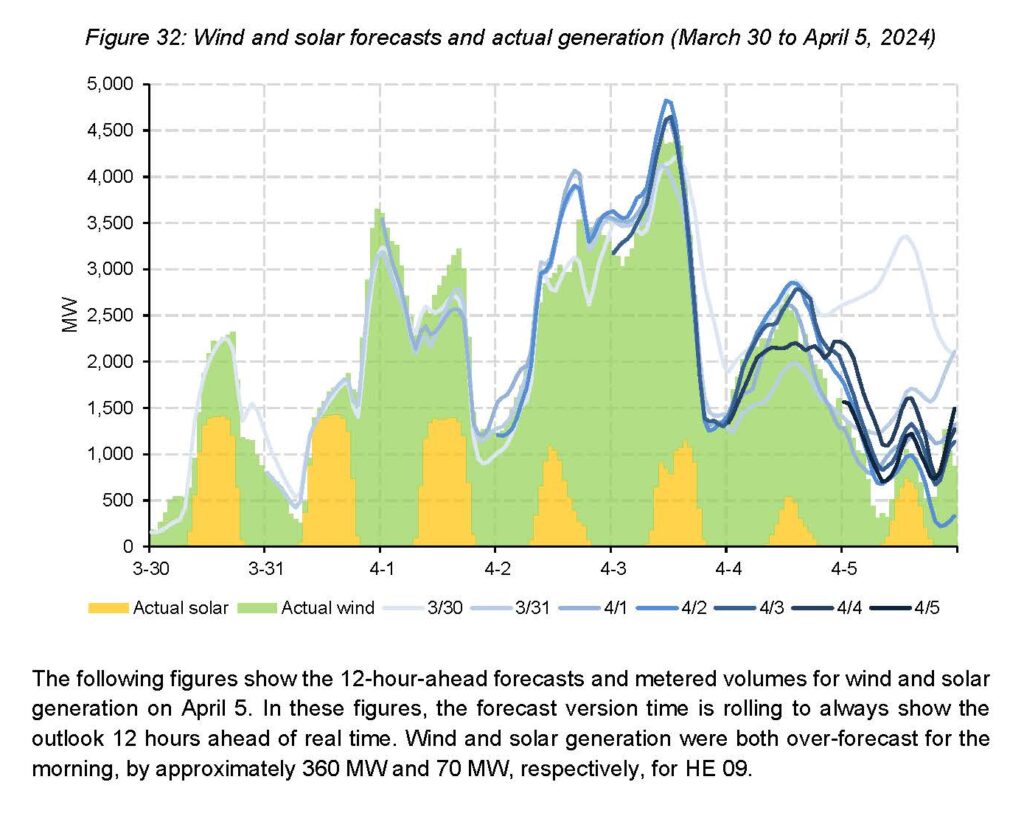
The green is wind power output. On April 3, it was doing great, but when the grid alert hit, it was producing only 4.2 per cent of nameplate capacity, around 200 megawatts from a potential 4,748 megawatts.
So while the report went to great lengths showing how various thermal units were down (many of which were down for maintenance scheduled months or years in advance), it doesn’t say a lot about how wind output was down 95.8 per cent from nameplate capacity when the alert was called. For instance, at 10:03 a.m., the 200 megawatt Forty Mile Grandlea wind facility was producing 3 megawatts. When the province was shedding load, it was producing only 15 megawatts.
The shortfall of wind compared to the forecast supply was substantial. It should be noted as this was in the earliest hours of the morning just around sunrise and a couple hours after, solar was not a factor. The sun was over Western Europe and then the Atlantic Ocean at the time.
- 0098 SASPO-2874_Self Serve Campaign_New Connects_Youtube_v30098 SASPO-2874_Self Serve Campaign_New Connects_Youtube_v3
- 0100 Turnbull Project Manager0100 Turnbull Project Manager
- 0099 Mryglod Steel 1080p0099 Mryglod Steel 1080p
- 0097 Eagle Sky Ventures LTD0097 Eagle Sky Ventures LTD
- 0095 Fast Trucking nearly 70 years good at it0095 Fast Trucking nearly 70 years good at it
- 0053 Kingston Midstream Westspur Alameda Click Before You Dig0053 Kingston Midstream Westspur Alameda Click Before You Dig
- 0092 Turnbull projects big and small0092 Turnbull projects big and small
- 0046 City of Estevan This is Estevan Teaser0046 City of Estevan This is Estevan Teaser
- 0087 Lori Carr Coal Expansion0087 Lori Carr Coal Expansion
- 0077 Caprice Resources Stand Up For Free Speech0077 Caprice Resources Stand Up For Free Speech
- 0076 Latus only0076 Latus only
- 0061 SIMSA 2024 For Sask Buy Sask0061 SIMSA 2024 For Sask Buy Sask
- 0055 Smart Power Be Smart with your Power office0055 Smart Power Be Smart with your Power office
- 0051 JML Hiring Pumpjack assembly0051 JML Hiring Pumpjack assembly
- 0049 Scotsburn Dental soft guitar0049 Scotsburn Dental soft guitar
- 0041 DEEP Since 2018 now we are going to build0041 DEEP Since 2018 now we are going to build
- 0032 IWS Summer hiring rock trailer music
- 0022 Grimes winter hiring
- 0021 OSY Rentals S8 Promo
- 0018 IWS Hiring Royal Summer
- 0013 Panther Drilling PO ad 03 top drive rigs
- 0006 JK Junior
- 0002 gilliss casing services0002 gilliss casing services
- 9002 Pipeline Online 30 sec EBEX9002 Pipeline Online 30 sec EBEX
- 9001
Solar output rising with the rising sun did eventually help solidify the situation as solar megawatts built up on the grid.
The report said, “The Supply Adequacy Report did not anticipate scarcity on April 5, while the Market Supply Cushion Report started predicting low supply cushion for April 5 in the evening of March 31. Neither report was effective in signaling the tight supply conditions that persisted after the load shed into the evening ramp on April 5.”
It also points out the AESO didn’t have a clue things were going to go bad until 3 a.m. that morning.
“As of midnight on April 5, there was no indication of reduced supply adequacy. As the early morning progressed, the first signs of shortage started around 03:00, showing some tightness during the morning ramp with adequate supply the rest of the day.
“By 04:00, contingency reserve shortages were predicted for HE 08. The forecast remained stable until approximately 06:30 when the code for HE 08 reached 0. The Supply Adequacy Report did not anticipate inadequate supply, although the outlook consistently worsened as conditions unfolded in real time.”
- 0098 SASPO-2874_Self Serve Campaign_New Connects_Youtube_v30098 SASPO-2874_Self Serve Campaign_New Connects_Youtube_v3
- 0100 Turnbull Project Manager0100 Turnbull Project Manager
- 0099 Mryglod Steel 1080p0099 Mryglod Steel 1080p
- 0097 Eagle Sky Ventures LTD0097 Eagle Sky Ventures LTD
- 0095 Fast Trucking nearly 70 years good at it0095 Fast Trucking nearly 70 years good at it
- 0053 Kingston Midstream Westspur Alameda Click Before You Dig0053 Kingston Midstream Westspur Alameda Click Before You Dig
- 0092 Turnbull projects big and small0092 Turnbull projects big and small
- 0046 City of Estevan This is Estevan Teaser0046 City of Estevan This is Estevan Teaser
- 0087 Lori Carr Coal Expansion0087 Lori Carr Coal Expansion
- 0077 Caprice Resources Stand Up For Free Speech0077 Caprice Resources Stand Up For Free Speech
- 0076 Latus only0076 Latus only
- 0061 SIMSA 2024 For Sask Buy Sask0061 SIMSA 2024 For Sask Buy Sask
- 0055 Smart Power Be Smart with your Power office0055 Smart Power Be Smart with your Power office
- 0051 JML Hiring Pumpjack assembly0051 JML Hiring Pumpjack assembly
- 0049 Scotsburn Dental soft guitar0049 Scotsburn Dental soft guitar
- 0041 DEEP Since 2018 now we are going to build0041 DEEP Since 2018 now we are going to build
- 0032 IWS Summer hiring rock trailer music
- 0022 Grimes winter hiring
- 0021 OSY Rentals S8 Promo
- 0018 IWS Hiring Royal Summer
- 0013 Panther Drilling PO ad 03 top drive rigs
- 0006 JK Junior
- 0002 gilliss casing services0002 gilliss casing services
- 9002 Pipeline Online 30 sec EBEX9002 Pipeline Online 30 sec EBEX
- 9001
But there was an accurate prediction of inadequate supplies via the Market Supply Cushion Report. “Like the January event, on April 5 the Market Supply Cushion Report more accurately predicted the time and severity of adequacy issues compared to the Supply Adequacy Report. However, like the Supply Adequacy Report, it did not predict the sustained supply tightness through the afternoon and early evening, with the 12:00 version showing a code of 3 from HE 14 onward,” the report said.
This has led to a recalculation of how the supply cushion is calculated, a major action item since these events. The report said, “The anticipated supply cushion was consistently below the threshold as of midday on April 3, including all of April 4. While the anticipated supply cushion calculation has been updated, this nonetheless suggests that Battle River 5, which was commercially offline during the event, would have received a directive if the Supply Cushion Regulation had been in effect. Had such a directive been issued and Battle River 5 successfully responded, load shed would not have been required.
As for interties, during the alert Alberta was bringing in in excess of 600 megawatts from its neighbours, including 153 megawatts from SaskPower. “Prices in Alberta were higher than in nearby jurisdictions on April 5. As a result, import capability was fully used over the EEA 3 event. Additionally, the AESO increased BC/MATL import capability beyond limits determined by LSS/FFR volumes. Following the Keephills 2 trip, the AESO requested Northwest Power Pool Reserve Sharing imports.”
“At the time that the April 5 EEA 3 event began (06:49), 270 MW of net imports were scheduled on BC and 166 MW of net imports were scheduled on MATL, with the 436 MW BC/MATL import capability being fully used. Additionally, 150 MW of net imports were scheduled on the SK intertie, out of the 153 MW SK import ATC. From HE 08 through HE 23, 153 MW was scheduled on the SK intertie, meaning that it was fully used over this period.”
UPDATE: The following day after the report was issued, wind power generation cratered again for much of the day. About 24 hours after the Aug. 6 press conference, Alberta’s wind power generation was producing 50 megawatts, roughly one per cent of nameplate capacity. And just before midnight the evening of Aug. 7, wind was producing 114 megawatts, with three quarters of that from one facility. The 40 of Alberta’s 46 wind farms were producing zero power.
- 0098 SASPO-2874_Self Serve Campaign_New Connects_Youtube_v30098 SASPO-2874_Self Serve Campaign_New Connects_Youtube_v3
- 0100 Turnbull Project Manager0100 Turnbull Project Manager
- 0099 Mryglod Steel 1080p0099 Mryglod Steel 1080p
- 0097 Eagle Sky Ventures LTD0097 Eagle Sky Ventures LTD
- 0095 Fast Trucking nearly 70 years good at it0095 Fast Trucking nearly 70 years good at it
- 0053 Kingston Midstream Westspur Alameda Click Before You Dig0053 Kingston Midstream Westspur Alameda Click Before You Dig
- 0092 Turnbull projects big and small0092 Turnbull projects big and small
- 0046 City of Estevan This is Estevan Teaser0046 City of Estevan This is Estevan Teaser
- 0087 Lori Carr Coal Expansion0087 Lori Carr Coal Expansion
- 0077 Caprice Resources Stand Up For Free Speech0077 Caprice Resources Stand Up For Free Speech
- 0076 Latus only0076 Latus only
- 0061 SIMSA 2024 For Sask Buy Sask0061 SIMSA 2024 For Sask Buy Sask
- 0055 Smart Power Be Smart with your Power office0055 Smart Power Be Smart with your Power office
- 0051 JML Hiring Pumpjack assembly0051 JML Hiring Pumpjack assembly
- 0049 Scotsburn Dental soft guitar0049 Scotsburn Dental soft guitar
- 0041 DEEP Since 2018 now we are going to build0041 DEEP Since 2018 now we are going to build
- 0032 IWS Summer hiring rock trailer music
- 0022 Grimes winter hiring
- 0021 OSY Rentals S8 Promo
- 0018 IWS Hiring Royal Summer
- 0013 Panther Drilling PO ad 03 top drive rigs
- 0006 JK Junior
- 0002 gilliss casing services0002 gilliss casing services
- 9002 Pipeline Online 30 sec EBEX9002 Pipeline Online 30 sec EBEX
- 9001
